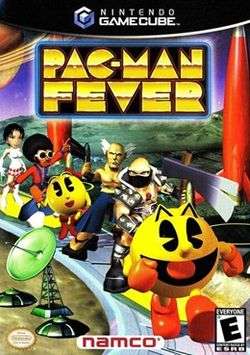Pac-Man Fever (video game)
| Pac-Man Fever | |
|---|---|
 Nintendo GameCube cover art | |
| Developer(s) | Mass Media Inc. |
| Publisher(s) | Namco |
| Platform(s) |
Nintendo GameCube PlayStation 2 |
| Release date(s) |
Nintendo GameCube PlayStation 2 |
| Genre(s) | Party |
| Mode(s) | Single-player, multiplayer |
Pac-Man Fever is a party game released for Nintendo GameCube, and PlayStation 2 in September 3, 2002 (The Nintendo GameCube's version was only released in North America). Like in many party video games, players move about on a virtual game board, with the object of the game being to reach the end first. It allows for up to four players, featuring six characters from other Namco games to choose from: Pac-Man, Astaroth, Heihachi Mishima, Ms. Pac-Man, Tiger Jackson, and Reiko Nagase. Another party game called Shrek Super Party has the same game developer.
Gameplay
There are three different types of game boards to play—Tropical, Space, and Medieval—each with its own set of minigames. After selecting a board, players can also choose to play a short, medium or long game, each game having a different amount of tiles that corresponded to the length's name.
The object of the game is to get to the goal space first. The game is played in rounds, each round begins with a four-player minigame, the results of which decides how many spaces each player moves forward on the board. Each tile on the board also has an effect. These include moving forward/going backward a few steps, losing/gaining/stealing tokens, playing a single/two-player minigame, the ability to spend earned tokens, and a raffle game to earn redemption tickets. When on a "store" tile, the player can spend tokens to: move steps forward, move others backward, buy raffle tickets, or gamble to earn more tokens. The three spaces before the goal space are raffle spaces for a redemption ticket of the fruit on the space (cherry, orange, and banana). The more raffle tickets you have for the fruit the better chance you have of winning the redemption ticket, also depending on the space you're on you need to place a certain rank or better in a minigame.
Once a player has reached the end, the game is over and players will receive redemption tickets based on how far they got on the board. These can then be used to buy each minigame separately, which can be played in short tournaments outside the main game. Alternatively, once all minigames have been bought, the player can let the tickets tally up to indicate their overall high score.
Reception
Pac-Man Fever, despite being resold as a Greatest Hits and Player's Choice title, received negative reviews. Matt Casamassina of IGN gave the GameCube version a 4.9/10,[2] and a 4.5/10 for the PlayStation 2 version.[3] While the sound was praised, the gameplay and graphics were criticized.
Review aggregator Metacritic gave the GameCube version a 54 out of 100, indicating "Mixed or average reviews",[4] while the PS2 version received a 47 out of 100, indicating "Generally unfavorable reviews.[5]
Ryan Davis of GameSpot gave both versions of the game a 5.2/10, disliking the lack of variety in the minigames, and the slow pace on the boards.[6]
References
- ↑ "Pac-Man Fever". IGN. Retrieved July 8, 2014.
- ↑ Casamassina, Matt (4 September 2002). "Pac-Man Fever".
- ↑ Casamassina, Matt (4 September 2002). "Pac-Man Fever PS2".
- ↑ "Pac-Man Fever".
- ↑ "Pac-Man Fever".
- ↑ "Pac-Man Fever Review".